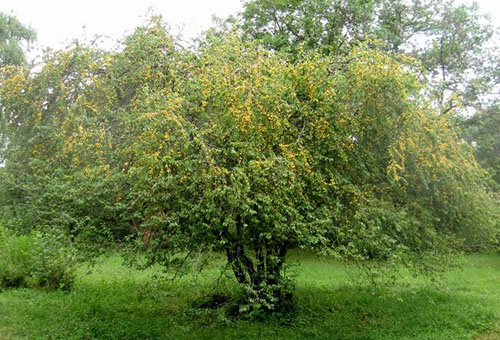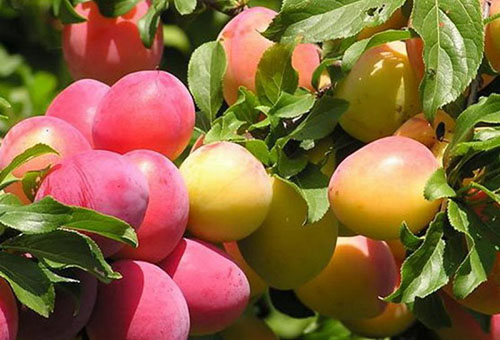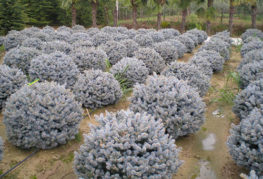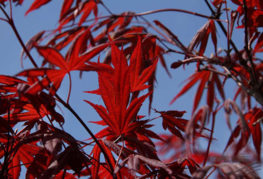Is it possible to plant and grow cherry plum in the middle lane?
Currently, you can grow fruit trees on your site, which previously took root only in the south. Planting and caring for cherry plum, of course, will have some peculiarities, but these measures are quite feasible and give hope for an excellent harvest.
First of all, you will have to choose one of the varieties specially bred for these conditions. Some of them grow well in Siberia, despite the fact that cherry plum is a plant in southern latitudes. These varieties include Nesmeyanu, Traveler, Kuban comet - with red fruits; Gold of the Scythians, Gift to St. Petersburg - with yellow. There are many other hardy varieties. All of them, in fact, are a hybrid obtained by crossing cherry plum and plum. However, they have great taste and rather large fruits.
Landing rules
Those varieties of cherry plum, which were bred for the middle lane, are mostly self-fertile. Therefore, it is required to plant several varieties of this tree nearby. It is better to give preference to those grown in the same area, this will allow the plant to take root better. You can consult about the choice in the nursery where the seedlings will be purchased.
Then it is important for the seedlings to choose the right place. Cherry plum is quite demanding in this respect. The plot for it must meet the following criteria:
- the place is well lit, if possible on a hill;
- a site protected from drafts;
- well-drained soil, free from stagnant water;
- the soil is rich in organic matter, fertile;
- the soil in terms of acid-base balance is as close to neutral as possible.
Planting should be done in spring. It is best to catch the time when it is already quite warm, the earth has warmed up, but the kidneys have not swollen yet. In the middle lane, this is approximately the beginning of April. However, not every year provides such an opportunity. In extreme cases, planting can be postponed to a later time if the root system is protected by a container.
Planting is done in the traditional way; cherry plum has no unique features in this matter. You need to dig a hole about half a meter in diameter and the same depth. Securely support a vertical support in this hole, such as a stick or stake. Then lower the root of the seedling into the hole, spread it out if possible and sprinkle it with fertile soil. It is good if the soil is pre-mixed with rotted manure and compost. The soil needs to be compacted by gentle pressing of the hands so as to close possible voids. It is very important not to deepen the neck at the same time - it should be located at least 3 cm above ground level. After that, the seedling must be tied to a support and watered. Watering one root will require about a bucket of water. Like many fruit trees, cherry plum responds well to soil mulching in the root zone. You can use traditional compost or peat for this.
Tree care
Correct landing is half the battle, the other half will be provided with competent care. Cherry plum does not require anything supernatural, leaving is simple, but mandatory. If everything is done in a timely manner and correctly, the harvest will be very rich. Cherry plum can produce up to 40 kg of fruits from one tree. Their color, size, taste depend on the variety, but good care is largely responsible for the quantity. It consists of the following points.
- Watering should be moderate. Cherry plum does not like excessive moisture. However, its roots are located quite close to the surface, so they can dry out, especially since planting is done in an open, elevated place.One adult tree consumes about 5 buckets of water at a time. Watering is not frequent, as the soil dries out.
- Weeding of the near-stem zone is carried out regularly. In this case, care can be noticeably facilitated by sowing the soil between the trees with low-growing herbaceous plants, such as clover. Cherry plum will tolerate such a neighborhood well, but planting clover will eliminate the need for regular weeding, since this plant displaces weeds.
- Pruning branches is a necessary procedure, without which caring for cherry plum will not be complete. First of all, diseased, damaged branches, as well as the so-called "tops" are cut off. Young, very elongated shoots are simply pinched. If you overdo it with pruning, you can harm the tree - cherry plum can get sunburn or freeze, which is especially important if the tree is grown in the middle lane.
- Fertilization and top dressing are usually done in the second year, if planting was accompanied by the introduction of a sufficient amount of manure and compost. Subsequently, fertilizing with mineral fertilizers is necessary, especially when the cherry plum begins to bear fruit. As planned, nitrogen fertilizers are applied in the spring, and potash and phosphorus fertilizers - in the fall. Such maintenance will significantly increase the volume of the crop, especially if manure and compost are applied every spring and autumn.
In addition to the above measures, caring for cherry plum includes the fight against diseases and pests, and better - the prevention of their defeat. If the gardener closely monitors the condition of his garden and processes the plantings, then everything can be done with preventive measures.
Cherry plum pests and diseases
Fortunately, cherry plum is quite resistant to pests. If you spray the plants in the garden at the same time, the tree will most likely not be affected. For cherry plum, such pests are dangerous as sawfly, apple scale, black and copper goldfish, as well as the most characteristic of all - the plum moth and the most common - aphid. Many fruit trees in the garden suffer from these pests, so usually gardeners regularly treat their plantings from them.
Advice
If aphids attack the cherry plum, you need to spray the tree with a decoction and infusion of plants, such as celandine, chamomile or garlic. In this case, the crop should be harvested after a month.
The diseases that plum suffers are also known to many. In this case, care consists in a timely response to their first signs and the correct measures to combat them. First of all, various fungal diseases are of great danger. Some of them should be considered in more detail.
- Milky shine.
It is expressed in the fact that the entire crown of the tree is covered with a silvery coating. From the outside, it may seem that the leaves have acquired some kind of metallic sheen. This is a sign of a dangerous fungal disease that causes stem rot. The leaves on such a tree become brown and dry by mid-July. If you notice the problem in time and have time to cut off the affected branches, then the tree can be saved. The place of the cut must be treated with a solution of copper sulfate, and then covered with pitch.
- Clasterosporium disease.
This disease is also called perforated leaf spot. From the name it is already clear that the disease is expressed in spots on the leaves, which appear in the spring and soon turn into holes. If the disease is not defeated in time, then it will affect the entire plant, including buds, flowers, fruits and branches. Eventually the cherry plum will stop growing. Against this disease, cherry plum must be treated with a solution of ferrous sulfate before the buds bloom, and then, when the flowering period is over, spray the tree with Bordeaux liquid.
- Gray rot.
This attack is familiar to almost all gardeners. In this case, the fruits wrinkle, acquire a lilac-gray color, and become covered with putrid granular formations.What is noteworthy is that this phenomenon quickly spreads to a healthy fetus at the place of its abutment to the patient, in a short time affecting it entirely. Such a tree should be sprayed with Bordeaux liquid during the leaf fall. The main thing is to regularly remove the fruits as soon as signs of rot appear on them. Fallen and plucked berries, as well as leaves, must be carefully collected and burned so that the spores contained on them do not attack the tree with renewed vigor after wintering.
Useful properties of cherry plum
Despite the fact that this green pet is native to the southern regions, it is very popular in central Russia. This is due not only to high yields and tasty fruits, but also to the great benefits that are inherent in cherry plum. The fruits of this tree contain many minerals, such as potassium, calcium, iron, magnesium, sodium, phosphorus, and in addition, vitamins of group B, PP, E, provitamin A, organic acids, pectin. The fruits and flowers of cherry plum are used in medicine.
First of all, cherry plum helps with vitamin deficiency and diseases associated with it. It normalizes bowel function, helps with constipation. The juice is used to treat colds typical for the inhabitants of the middle lane: cough, some stomach disorders. Cherry plum strengthens the heart muscle, nervous system, normalizes blood pressure. Water tincture of cherry plum flowers helps to cope with kidney and liver diseases.
Such a number of useful qualities cannot leave anyone indifferent. Moreover, planting cherry plum and caring for it are not too difficult. Growing cherry plum is an excellent solution for any garden, because thanks to selection it has become possible in the climate of the middle zone. It remains only to choose the best varieties and decorate your garden with a beautiful cherry plum.








and will be published shortly.